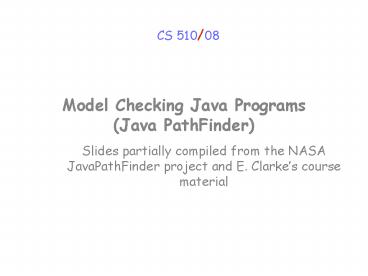Model Checking Java Programs Java PathFinder PowerPoint PPT Presentation
1 / 34
Title: Model Checking Java Programs Java PathFinder
1
Model Checking Java Programs (Java PathFinder)
CS 510/08
- Slides partially compiled from the NASA
JavaPathFinder project and E. Clarkes course
material
2
Java PathFinder
- JPF is an explicit state software model checker
for Java bytecode - JPF is a Java virtual machine that executes your
program not just once (like a normal VM), but
theoretically in all possible ways, checking for
property violations like deadlocks or unhandled
exceptions along all potential execution paths.
3
Symbolic Model Checking
Program
Analysis Engine
SAT Solver
CNF
Claim
UNSAT (no counterexample found)
SAT (counterexample exists)
4
Explicit State Model Checking
- The program is indeed executing
- jpf ltyour classgt ltparametersgt
- Very similar to java ltyour classgt ltparametersgt
- Execute in a way that all possible scenarios are
explored - Thread interleaving
- Undeterministic values (random values)
- Concrete input is provided
- A state is indeed a concrete state, consisting of
- Concrete values in heap/stack memory
5
JPF Status
- developed at the Robust Software Engineering
Group at NASA Ames Research Center - currently in its fourth development cycle
- v1 Spin/Promela translator - 1999
- v2 backtrackable, state matching JVM - 2000
- v3 extension infrastructure (listeners, MJI) -
2004 - v4 symbolic execution, choice generators - 4Q
2005 - open sourced since 04/2005 under NOSA 1.3
licenseltjavapathfinder.sourceforge.netgt - its a first no NASA system development hosted
on public site before - 11100 downloads since publication 04/2005
6
An Example
7
An Example (cont.)
- One execution corresponds to one path.
8
(No Transcript)
9
(No Transcript)
10
- JPF explores multiple possible executions GIVEN
THE SAME CONCRETE INPUT
11
Another Example
12
(No Transcript)
13
(No Transcript)
14
Two Essential Capabilities
- Backtracking
- Means that JPF can restore previous execution
states, to see if there are unexplored choices
left. - While this is theoretically can be achieved by
re-executing the program from the beginning,
backtracking is a much more efficient mechanism
if state storage is optimized. - State matching
- JPF checks every new state if it already has seen
an equal one, in which case there is no use to
continue along the current execution path, and
JPF can backtrack to the nearest non-explored
non-deterministic choice - Heap and thread-stack snapshots.
15
The Challenge
16
The Challenge (cont.)
State Explosion!!
17
JPFs Solution
- Configurable search strategy
- Directing the search so that defects can be found
quicker - A debugging tool instead of a proof system.
- User can easily develop his/her own strategy
- Host VM Execution
- Delegate execution to the underlying host VM (no
state tracking). - Reducing state storage
- State collapsing
- Premise only a tiny part of the state is changed
upon each transaction. (e.g. a single stack
frame) - Dividing a state into components, use hashtable
to index a specific value for a component.
18
Solution- State Collapsing
19
Solution (3) State Reduction
- Orthogonal (our focus)
- State Abstraction
- Partial Order Reduction
20
Abstraction
- Eliminate details irrelevant to the property
- Obtain simple finite models sufficient to verify
the property - Disadvantage
- Loss of Precision False positives/negatives
21
Data Abstraction
S
S
Abstraction Function h from S to S
22
Data Abstraction Example
- Abstraction proceeds component-wise, where
variables are components
, -2, 0, 2, 4,
xint
, -3, -1, 1, 3,
, -3, -2, -1
yint
0
1, 2, 3,
23
How do we Abstract Behaviors?
- Abstract domain A
- Abstract concrete values to those in A
- Then compute transitions in the abstract domain
24
Data Type Abstraction
Abstract Data domain
Code
int x 0 if (x 0) x x 1
25
Existential/Universal Abstractions
- Existential
- Make a transition from an abstract state if at
least one corresponding concrete state has the
transition. - Abstract model M simulates concrete model M
- Universal
- Make a transition from an abstract state if all
the corresponding concrete states have the
transition.
26
Existential Abstraction (Over-approximation)
I
S
I
S
27
Universal Abstraction (Under-Approximation)
I
S
I
S
28
Guarantees from Abstraction
- Assume M is an abstraction of M
- Strong Preservation
- P holds in M iff P holds in M
- Weak Preservation
- P holds in M implies P holds in M
29
Guarantees from Exist. Abstraction
- Let f be a hold-for-all-paths property
- M existentially abstracts M
M
- Preservation Theorem
- M ? f ? M ? f
M
- Converse does not hold
- M ? f ? M ? f
- M ? f counterexample may be spurious
30
Guarantees from Univ. Abstraction
- Let f be a existential-quantified property and
M simulates M
- Preservation Theorem
- M ? f ? M ? f
- Converse does not hold
- M ? f ? M ? f
31
Spurious counterexample in Over-approximation
32
Refinement
- Problem Deadend and Bad States are in the same
abstract state. - Solution Refine abstraction function.
- The sets of Deadend and Bad states should be
separated into different abstract states.
33
Refinement
h
Refinement h
34
Automated Abstraction/Refinement
- Good abstractions are hard to obtain
- Automate both Abstraction and Refinement
processes - Counterexample-Guided AR (CEGAR)
- Build an abstract model M
- Model check property P, M ? P?
- If M ? P, then M ? P by Preservation Theorem
- Otherwise, check if Counterexample (CE) is
spurious - Refine abstract state space using CE analysis
results - Repeat
35
Counterexample-Guided Abstraction-Refinement
(CEGAR)
Model Check
Build New Abstract Model
M
M
Pass
No Bug
Fail
Check Counterexample
Obtain Refinement Cue
Real CE
Spurious CE
Bug

